Ready to leap into a industry of brain-teasing fun? We’ve gathered the most ribbiting riddles about frogs that’ll have you hopping with excitement. These green amphibian puzzles are perfect for challenging friends, entertaining kids, or simply enjoying a mental workout.
From classic wordplay to clever conundrums, frog riddles strike the perfect balance between education and entertainment. They’re not just amusing – they’re also fantastic tools for developing critical thinking skills and expanding vocabulary. We’ve compiled everything from easy tadpole teasers for beginners to complex lily pad puzzles that will challenge even the most experienced riddle enthusiasts.
10 Mind-Boggling Riddles About Frogs for All Ages
- What has a wide mouth but never speaks?
A frog! These amphibians have characteristically wide mouths perfect for catching insects but can’t form words like humans do.
- What do you call a frog that parks illegally?
Toad! This play on words works because toads are related to frogs, and “towed” sounds just like a vehicle being removed for parking violations.
- Why couldn’t the frog use the phone?
Because it kept hopping all over the buttons! Frogs’ natural jumping behavior makes this riddle particularly amusing for younger audiences.
- What’s green and jumps a mile high?
A frog with hiccups! This silly riddle combines the frog’s green color with an exaggerated jumping ability caused by an everyday human condition.
- How do frogs drink?
They don’t—they absorb water through their skin! This science-based riddle teaches about the unique physiology of frogs while challenging common assumptions.
- What happens when two frogs collide?
They get tongue-tied! This clever wordplay refers to both the literal entanglement of their long sticky tongues and the expression for being unable to speak clearly.
- Which books do frogs enjoy reading?
Ones with fly pages! This riddle plays on “fly pages” (thin paper in books) and flies being a favorite food of frogs.
- How do you know when a frog is unhappy?
It’s feeling jumpy! This riddle uses the double meaning of “jumpy” as both a frog’s natural movement and feeling anxious or nervous.
- What do you call a frog that crosses the road?
Roadkill! While slightly dark humor, this riddle plays on the common “why did the chicken cross the road” format with an unexpected punchline.
- Where do frogs keep their money?
In a river bank! This classic riddle cleverly connects the financial institution with the natural habitat of frogs along the edges of rivers.
The Classic Frog-Crossing-the-River Riddle
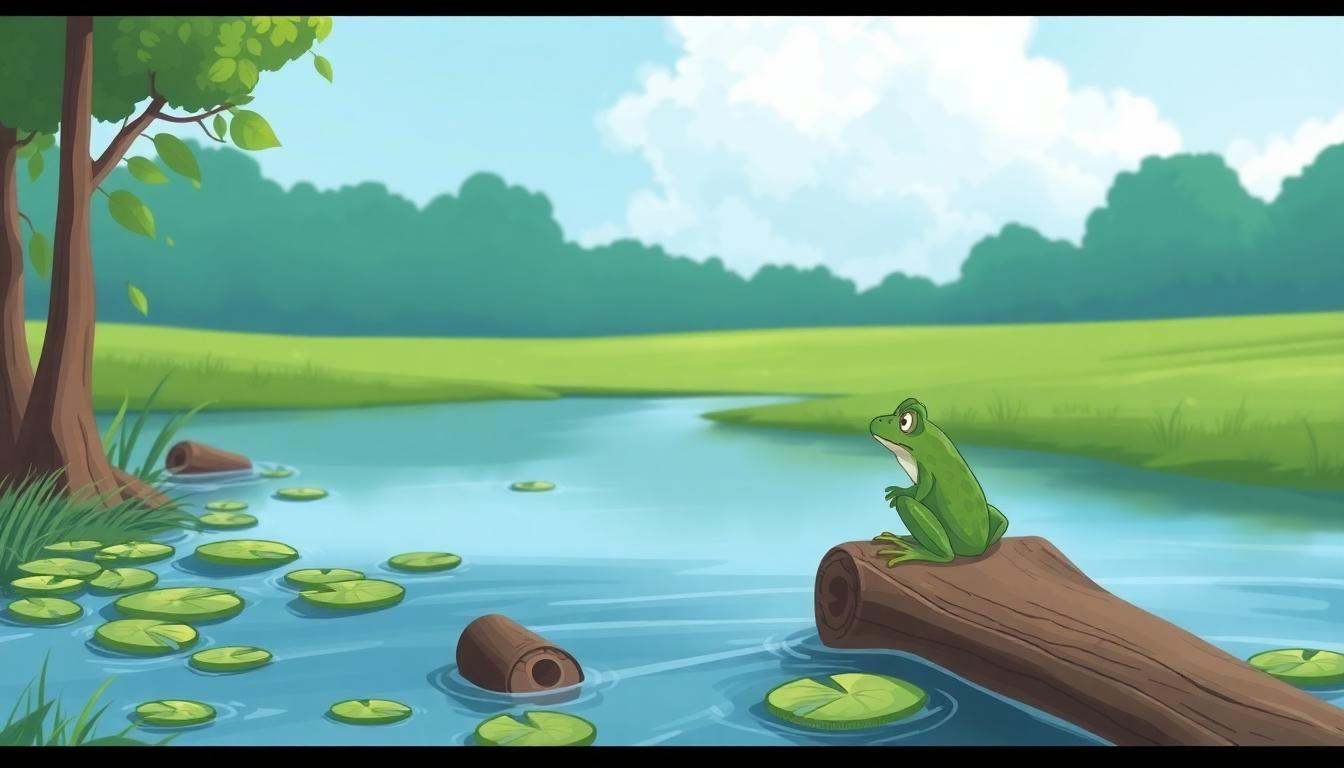
The frog-crossing-the-river riddle represents a classic problem-solving puzzle that challenges logical thinking. While not exclusively about frogs, this brain teaser uses our amphibian friends as central characters in a memorable scenario.
Solution and Explanation
The traditional frog-crossing-the-river riddle typically involves a frog attempting to cross a river with exact constraints. In most versions, the frog can only jump certain distances or must use limited resources like lilypads or logs to reach the other side. The solution requires careful planning and sequential thinking, often involving backtracking or counterintuitive moves. Many solvers initially attempt direct paths across the river, only to discover that successful crossing requires strategic planning, making this riddle particularly satisfying when solved.
Variations Across Cultures
Frog-themed riddles appear in various forms across different cultures, each emphasizing unique aspects of these amphibians. Western variations often focus on wordplay involving hopping, croaking, or catching flies, such as the humorous “What happens if a frog parks in a bus stop? It gets toad away!” Some cultures view frogs as symbols of transformation or good fortune, influencing their riddle traditions. In Asian folklore, frogs sometimes represent prosperity, creating riddles that play on this symbolism rather than physical characteristics. While exact international examples aren’t widely documented, the versatility of frog-centered puzzles demonstrates their universal appeal across cultural boundaries.
Wordplay Riddles Featuring Our Amphibian Friends
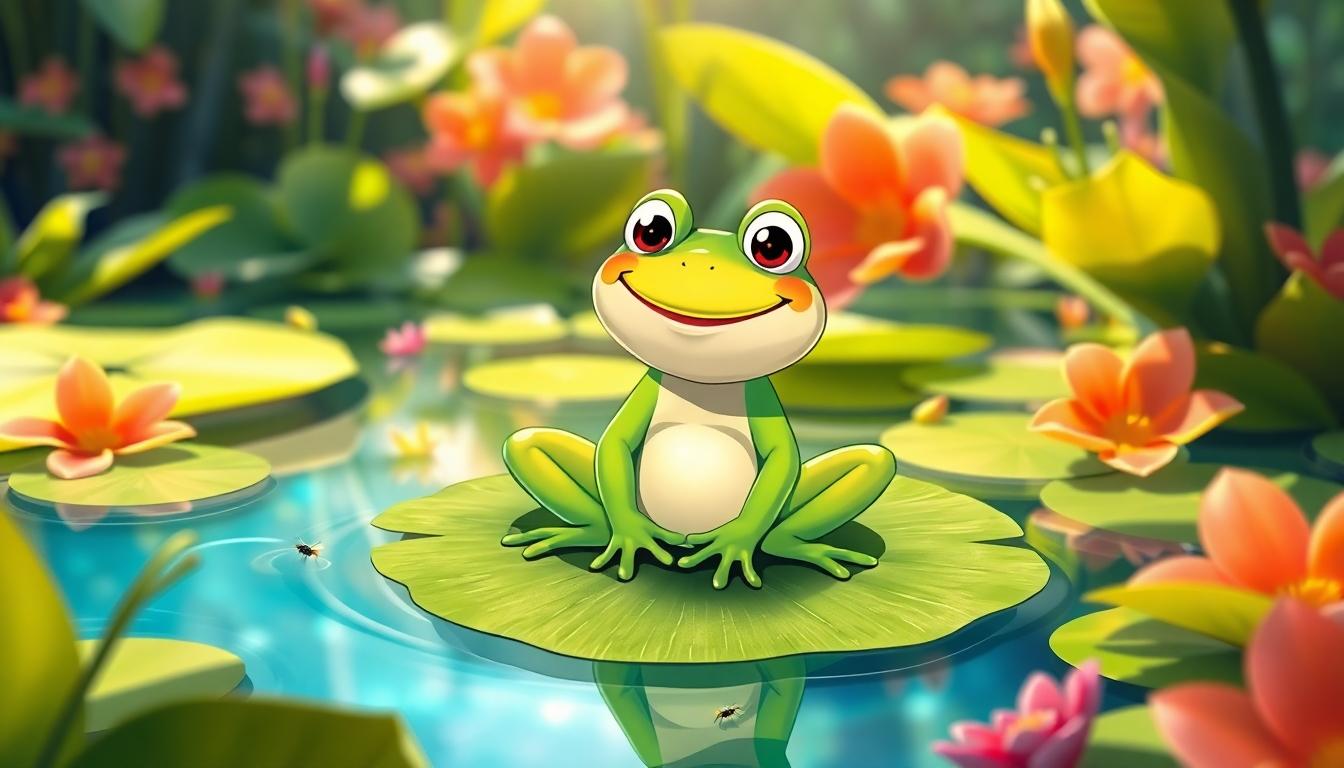
Frogs make perfect subjects for wordplay and riddles due to their distinctive characteristics and behaviors. We’ve collected some of the most entertaining frog-themed brainteasers that showcase clever linguistic twists and puns.
Pun-tastic Frog Riddles
Frog puns add a splash of humor to any riddle collection, creating memorable wordplay that’s sure to generate laughs. A popular example asks: “What do you call a frog spy?” with the amusing answer being “A croak and dagger agent.” Vehicle troubles aren’t exempt from frog humor either—when asked what happened when the frog’s car broke down, the answer is simply that “He jump-started it.” Literary frogs have their own brand of humor too, as evidenced by what a frog might say about his favorite book: “Reddit, reddit, reddit.” These playful riddles blend amphibian characteristics with everyday scenarios, creating unexpected punchlines that appeal to riddle enthusiasts of all ages.
Tongue Twisters With Frogs
Tongue twisters featuring frogs challenge your pronunciation skills while celebrating these hopping creatures. “Five feisty frogs frolicking fearlessly on a foggy Friday” showcases the classic repetition of the “f” sound that makes tongue twisters both challenging and enjoyable. Creating effective frog-themed tongue twisters typically involves incorporating consonant sounds that require precise articulation when repeated in quick succession. Sounds like “f,” “r,” and “c” work particularly well when crafting frog-focused verbal challenges. These linguistic exercises not only entertain but also help improve speech clarity and vocal dexterity while keeping our amphibian friends at the center of the fun.
Mathematical Riddles With Jumping Frogs
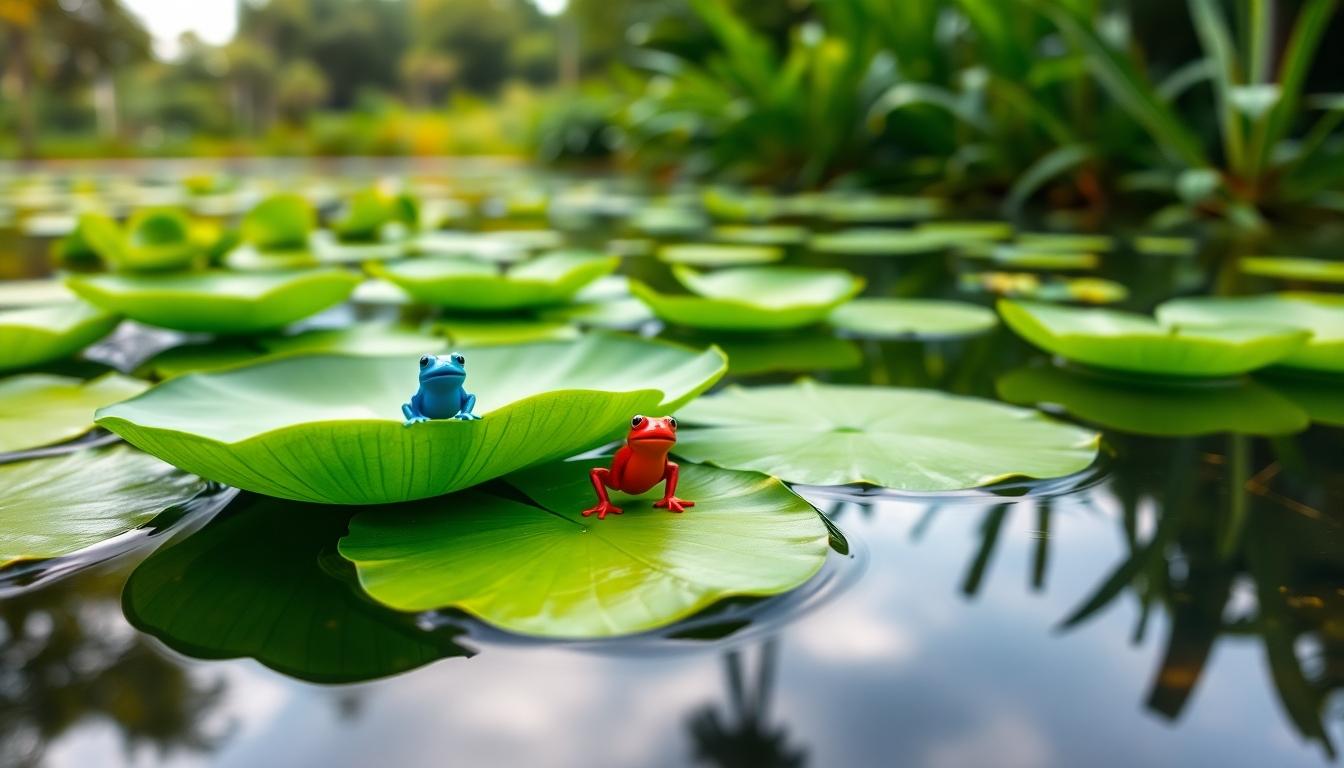
Jumping frog puzzles represent a fascinating intersection of recreational mathematics and strategic thinking. These brain teasers challenge players to maneuver frogs between positions following exact movement rules, revealing elegant mathematical patterns beneath seemingly simple gameplay.
The Classic Jumping Frogs Puzzle
The traditional jumping frogs puzzle features two groups of frogs (typically red and blue) positioned on lily pads. Your objective is to swap their positions completely using only two types of moves: slides to adjacent empty pads and jumps over frogs of the opposite color. Each puzzle configuration follows predictable mathematical patterns based on the number of frogs. For a setup with n frogs per side, the minimum required moves can be calculated with jumps equaling n² and slides equaling 2n. This means one frog per side requires 3 moves, two frogs need 8 moves, and three frogs demand 15 moves to complete the swap.
Solving these puzzles requires understanding the constraints: frogs can’t move backward, can’t jump over same-colored frogs, and can’t skip more than one lily pad at a time. The mathematical beauty emerges when we track the solution patterns, often notated with S (slide) and J (jump) to represent each move in the sequence.
The Lily Pad Calculation Challenge
The lily pad calculation challenge takes the puzzle further by asking players to determine the minimum number of moves needed under various constraints. Participants must carefully calculate each potential move while ensuring frogs never backtrack or make illegal jumps. NRICH problem-solving exercises demonstrate that for asymmetric setups with r red frogs versus b blue frogs, the total moves can be calculated as r × b (for jumps) plus r + b (for slides).
Players often discover that seemingly minor changes to initial conditions can dramatically affect solution complexity. Strategic planning becomes essential as each move impacts all future possibilities, making this a perfect exercise for developing logical thinking and pattern recognition skills.
Frog Population Puzzles
Frog population puzzles increase complexity by varying the numbers of frogs and lily pads in play. Distinct mathematical patterns emerge based on symmetry conditions. Symmetrical setups with equal numbers of frogs on each side show that required moves grow quadratically with the number of frogs per side, following elegant mathematical progressions.
Asymmetrical configurations reveal different patterns, where the total jumps equal the product of the two groups’ sizes. For example, a puzzle with 2 red frogs versus 3 blue frogs will require exactly 6 jumps (2 × 3) plus 5 slides (2 + 3) to solve optimally. Finding optimal paths depends on executing a precise sequence of sliding and jumping moves to avoid reaching deadlock positions where no legal moves remain.
These puzzles strengthen combinatorial thinking skills while demonstrating how simple rules can generate complex problem spaces with surprising mathematical properties. The satisfaction comes not just from solving each puzzle but from discovering the underlying patterns that connect them all.
Ancient Folk Riddles About Frogs and Toads

Frog riddles have captivated human imagination across diverse cultures throughout history, reflecting our fascination with these amphibious creatures. From playful puns to deeper symbolic meanings, these ancient puzzles showcase the universal appeal of frogs in folklore and mythology.
Egyptian Frog Riddles
Ancient Egyptians held frogs in particularly high regard, viewing them as powerful symbols of fertility and new life. This reverence stemmed directly from the annual flooding of the Nile River, when countless frogs would appear alongside the life-giving waters. Heqet, the frog-headed goddess of childbirth and fertility, embodied this connection between frogs and creation in Egyptian mythology. Though few direct riddles from this era have survived intact, archaeological evidence suggests riddles likely highlighted this duality of frogs emerging from mud yet heralding life. A reconstructed example might have posed: “I emerge with the flood, heralding life, yet dwell in mud” – capturing the essence of how Egyptians perceived these amphibians as messengers of fertility and regeneration.
Asian Cultural Frog Enigmas
Throughout Asia, frogs have traditionally symbolized prosperity, good fortune, and the essential life-giving properties of rain. Chinese folklore particularly celebrates the three-legged toad as a powerful symbol of wealth and abundance. These cultural associations likely inspired riddles connecting frogs to prosperity, such as “I dwell in coins, yet croak at the moon” – referencing the common motif of three-legged toads depicted on Chinese coins. Japanese culture offers another fascinating linguistic dimension, as their word for frog (kaeru) shares pronunciation with the word meaning “to return.” This connection has generated many wordplays and likely inspired riddles linking frogs to concepts of homecoming and returning fortune. Even though their different cultural contexts, Asian frog riddles consistently emphasize themes of transformation, prosperity, and the cyclical nature of life that frogs naturally represent through their remarkable metamorphosis.
Modern Frog Riddles for Children

We’ve collected some fun and modern riddles about frogs that kids will love to solve. These playful brain teasers combine humor with educational elements to entertain children while teaching them about these fascinating amphibians.
- Q: Green and bouncy, I love to leap, croaking and catching bugs while the pond is deep. What am I?
A: A frog. - Q: What happens if a frog parks in a bus stop?
A: He gets toad away! - Q: Why are frogs always happy?
A: Because they eat whatever bugs them. - Q: What is a frog’s favorite game?
A: Leapfrog.
Educational Riddles About Frog Anatomy
These clever riddles help children learn about frog anatomy through fun wordplay and descriptive clues. Each puzzle highlights unique physical characteristics that make frogs special in the animal kingdom.
- Q: I have webbed feet and can jump far, my tongue is long to catch insects from afar. What am I?
A: A frog. - Q: I start with gills in water, but grow lungs on land, helping me breathe so grand. What am I?
A: A tadpole transforming into a frog.
Eco-Friendly Frog Habitat Puzzles
Our environmental puzzles focus on where frogs live and how they interact with their surroundings. These riddles encourage children to think about conservation and the importance of protecting natural habitats.
- Q: In what kind of environment do frogs typically thrive?
A: Wetlands or near ponds. - Q: What kind of plants provide shelter for frogs?
A: Aquatic plants like lily pads and cattails.
Picture Riddles Featuring Frogs

Picture riddles featuring frogs combine visual elements with brain-teasing challenges, creating an captivating puzzle experience. These visual conundrums often require interpretation of images to discover a frog-related answer, making them appealing for puzzle enthusiasts of all ages.
Visual Puzzles and Optical Illusions
Visual puzzles involving frogs present a unique cognitive challenge that tests our pattern recognition abilities. Optical illusions with frog themes typically conceal amphibian silhouettes within larger, more complex images. These cleverly designed puzzles require viewers to shift their perspective or focus on exact visual elements to reveal the hidden frog. Many artists create these illusions by incorporating frog-shaped negative space within nature scenes or by using color contrast to camouflage the amphibian outline. Skilled puzzle creators often place frogs within contexts that make logical sense—such as ponds, lily pads, or forest floors—while still maintaining the challenge of discovery.
“Find the Hidden Frog” Challenges
“Find the Hidden Frog” challenges represent a popular subset of picture puzzles that sharpen observation skills through fun, frog-themed searches. These puzzles typically feature deliberately camouflaged frogs nestled among distracting elements, requiring careful scanning of the entire image. Educational materials frequently incorporate these challenges to develop children’s visual discrimination and problem-solving abilities. Online puzzle communities regularly share increasingly difficult frog-finding challenges, with some images containing multiple hidden amphibians of varying sizes. The appeal of these puzzles lies in their accessibility—simple enough for beginners yet potentially challenging for experienced puzzlers when the frogs are expertly concealed. Digital versions sometimes include interactive elements, allowing players to click when they spot the hidden frog and receive immediate feedback on their discovery.
Frog-Themed Lateral Thinking Puzzles
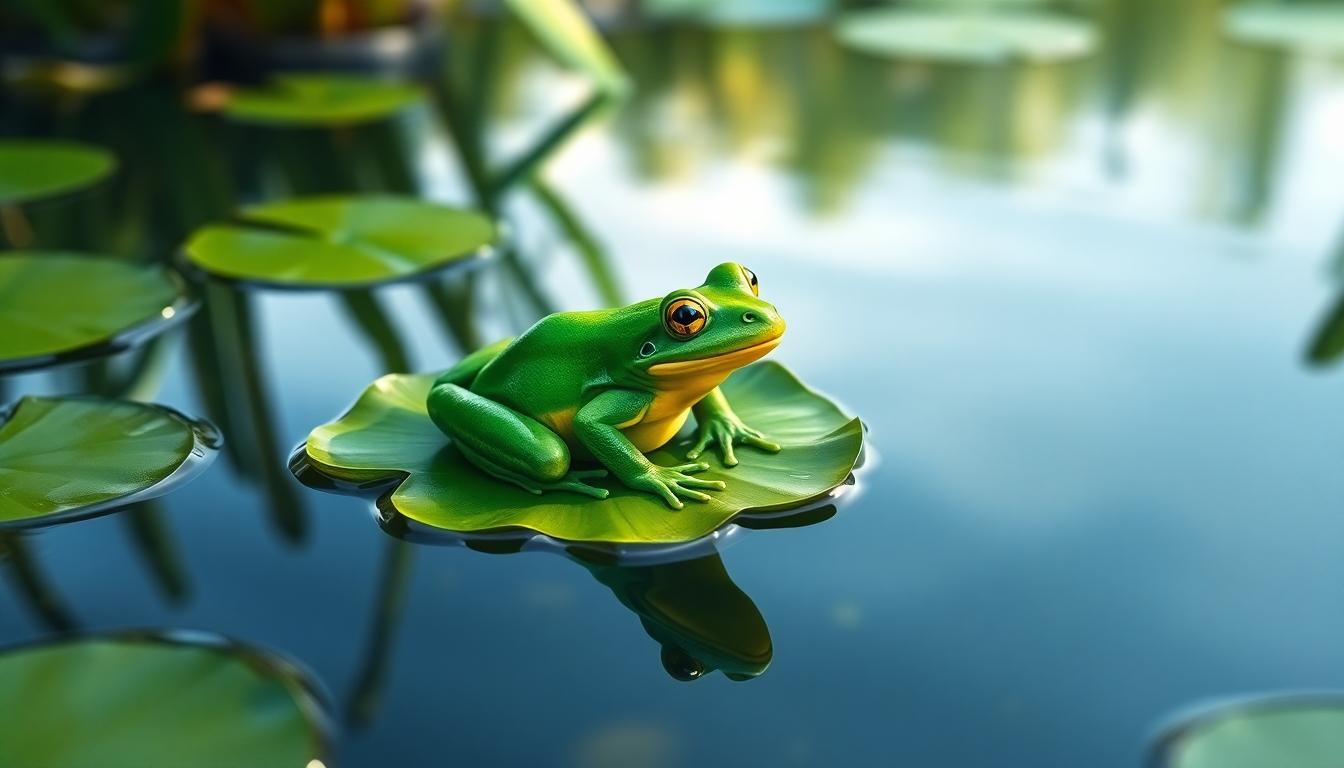
Lateral thinking puzzles featuring frogs challenge our conventional reasoning by requiring us to approach problems from unexpected angles. These brain teasers often incorporate unique amphibian characteristics while testing our ability to consider alternative perspectives and question assumptions.
Problem-Solving With Frogs
One of the most intriguing frog-based lateral thinking puzzles involves a survival scenario in a rainforest. In this classic brainteaser, you’ve accidentally ingested poison and discover that female frogs in the area secrete an antidote. You encounter either a single quiet frog or two frogs where one is croaking (confirming it’s male). The optimal choice requires Bayesian probability analysis rather than intuition. With a single frog, you have a straightforward 50% chance of finding a female. But, when facing two frogs with one confirmed male, your probability jumps to 2/3 chance of finding at least one female, as the croaking eliminates the female-female possibility from the potential combinations. This puzzle demonstrates how conditional information fundamentally alters probability assessment, making it a favorite among mathematicians and puzzle enthusiasts.
Logic Puzzles With Amphibian Twists
Frogs feature prominently in logic puzzles that challenge our problem-solving abilities through misdirection. A particularly clever example presents a scenario with a frog on a lily pad in the center of a 7-meter-diameter pond. Even though having six lily pads forming a path to the edge, the puzzle states the frog can’t escape. Many people frantically calculate jumping distances or pattern configurations before realizing the critical detail: the frog is dead. This deceptively simple puzzle teaches us to scrutinize all parameters before diving into complex answers. The key to solving frog-themed lateral thinking puzzles often lies in questioning our assumptions and paying attention to seemingly minor details that contain critical information. These puzzles leverage our familiarity with amphibian traits like croaking, jumping abilities, and even toxin secretion to create captivating scenarios that challenge conventional thinking patterns.
Interactive Riddles for Frog Enthusiasts

Scavenger Hunt Riddles
Scavenger hunt riddles about frogs create captivating outdoor learning experiences that combine problem-solving with nature exploration. These hunts typically incorporate clues about exact frog habitats that participants must decode to find their next location. For instance, riddles like “I burrow below when it’s dry and hot” guide seekers toward areas where spadefoot toads might be found. Creative clues often highlight distinctive amphibian behaviors, such as “I can make a leap without legs and never touch the ground,” challenging participants to think beyond literal interpretations. Many educators and nature centers design these hunts to teach about local frog species while keeping the activity fun and interactive for all ages.
Digital Frog Riddle Games
Online platforms have embraced amphibian-themed puzzles, transforming traditional riddles into immersive digital experiences. These games frequently challenge players to identify frog species through descriptive clues, such as “I’m named after a bull, but I don’t moo” for bullfrogs. Virtual escape rooms featuring frog-themed challenges have gained popularity, requiring players to solve interconnected riddles about amphibian morphology, life cycles, and ecology. Educational apps often incorporate riddles that highlight endangered species, like “Golden as the sun, I’m rare to see. My skin shines bright, like jewelry on me!” which describes the golden poison frog. These digital formats pair entertaining puzzles with informative explanations that reinforce scientific learning while maintaining an captivating gameplay experience for frog enthusiasts of all ages.
Using Frog Riddles in Educational Settings
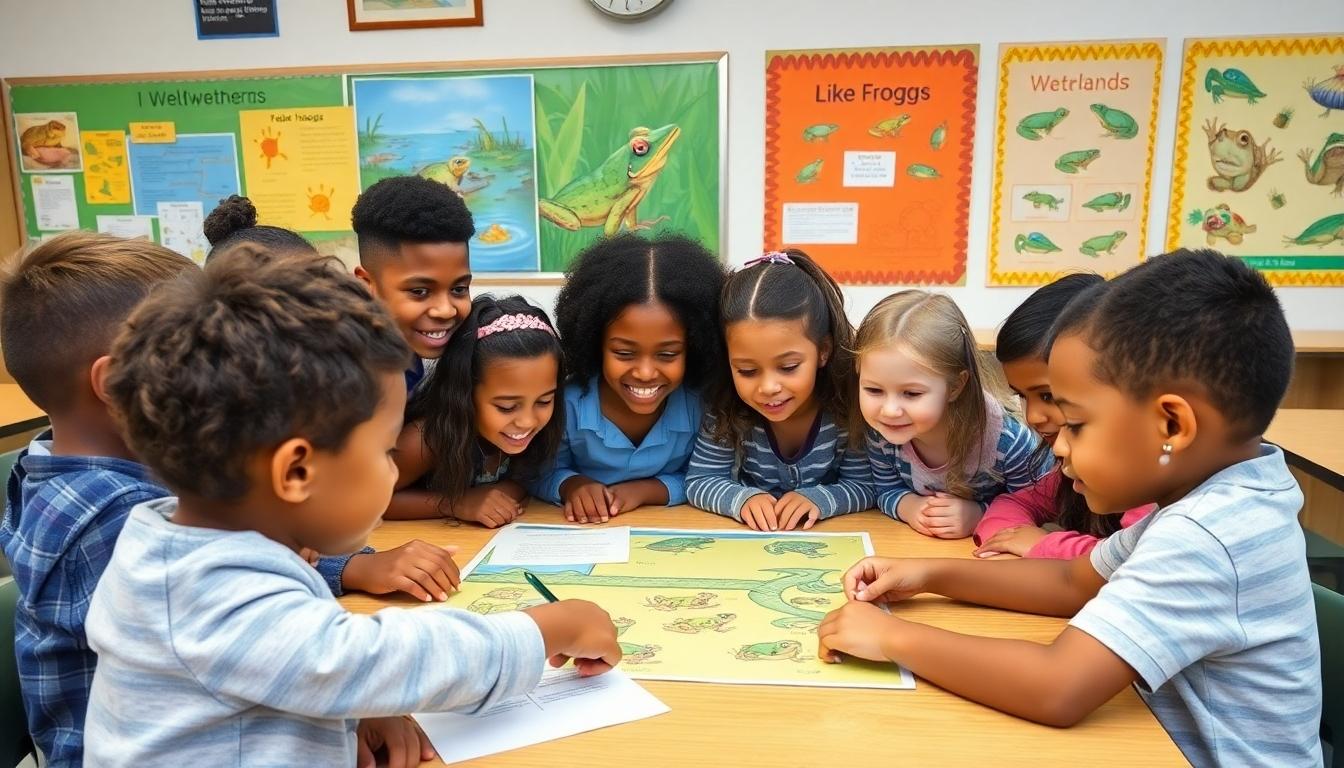
Frog-themed riddles serve as powerful educational tools that promote critical thinking and language development while aligning perfectly with ecological education goals. Research confirms that these playful puzzles enhance problem-solving skills, creativity, and focus in classroom environments.
Classroom Activities
Teachers can integrate frog riddles into math exercises by having students solve addition or subtraction problems to decode riddle answers. These mathematical connections make learning more captivating and memorable for young students. Literacy tasks benefit tremendously from frog riddles, as they provide opportunities to analyze wordplay and rhyming patterns that strengthen language comprehension. For instance, the riddle “What happens when frogs park illegally? They get toad!” teaches students about homophones (“toad” vs. “towed”) while introducing humor structure that aids vocabulary retention. Group riddle-solving sessions foster collaborative learning environments where students develop stronger peer bonds through shared problem-solving experiences. Cross-curricular integration allows educators to combine riddle-solving with science lessons about life cycles, mathematical problem sets, and creative writing assignments in language arts.
Environmental Awareness Through Riddles
Frog riddles naturally incorporate ecological themes that introduce important concepts about amphibian habitats and conservation efforts to young learners. Consider this example: “I leap in ponds but can’t swim; my voice is loud, yet I’m slim. What am I?” Such riddles spark meaningful discussions about frog anatomy and wetland ecosystems while fostering early environmental stewardship. Teachers can effectively link these activities to biology units or Earth Day projects to reinforce sustainability messages in memorable ways. Digital adaptations of frog-themed riddle activities are now available on platforms like Teachers Pay Teachers, enabling seamless implementation in remote or hybrid learning environments. Many educators use these riddles as formative assessments to gauge student comprehension of ecological or linguistic concepts while maintaining high engagement levels. Studies show that this approach improves cognitive flexibility and student engagement, making frog riddles particularly effective for K-5 education settings.
Why Frog Riddles Remain Timeless Brain Teasers
Frog riddles have hopped their way into our hearts across cultures and generations for good reason. They’re perfect mental exercises that blend humor with learning while challenging our thinking skills in unexpected ways.
From ancient Egyptian mythology to modern digital games these amphibian brain teasers connect us to nature and each other. Whether you’re solving mathematical lily pad puzzles or laughing at pun-filled jokes we’ve seen how frogs inspire both creativity and critical thinking.
So next time you need a fun activity for children a classroom exercise or just a brain break try a frog riddle. These clever puzzles aren’t just entertaining – they’re leaping opportunities for growth learning and connection with our natural industry.
Frequently Asked Questions
What makes frog riddles appealing to children?
Frog riddles combine humor with educational elements that entertain while teaching children about amphibians. They feature playful wordplay about frogs’ unique characteristics like jumping abilities and wide mouths. These riddles develop critical thinking skills, expand vocabulary, and often include eco-friendly themes that introduce conservation concepts in an accessible way. The visual nature of frog imagery makes these riddles especially engaging for younger audiences.
How can frog riddles be used in educational settings?
Frog riddles serve as versatile teaching tools that promote critical thinking, language development, and ecological awareness. Teachers can integrate them into math exercises, literacy tasks, and science lessons about amphibian life cycles. They work well as ice-breakers, brain teasers during transitions, or components of broader environmental education units. Digital adaptations make them suitable for remote learning while allowing educators to assess comprehension of both language concepts and ecological principles.
What mathematical concepts do frog jumping puzzles teach?
Frog jumping puzzles introduce core mathematical concepts like pattern recognition, sequential reasoning, and combinatorial problem-solving. The classic lily pad puzzle demonstrates mathematical properties related to minimum required moves based on the number of frogs. These puzzles teach strategic thinking, recursive problem-solving, and spatial reasoning in an engaging format. They also illustrate how simple rules can generate surprisingly complex mathematical challenges with elegant solutions.
How do frog riddles vary across different cultures?
Frog riddles reflect cultural significance across civilizations. Western riddles typically emphasize wordplay and puns based on frog behaviors. Egyptian mythology features riddles connecting frogs to fertility through the goddess Heqet. Asian cultures, particularly Chinese folklore, present frogs as symbols of prosperity with the three-legged toad representing wealth. Japanese riddles often connect frogs to homecoming concepts. These cultural variations showcase universal fascination with frogs while highlighting regional symbolic meanings.
What types of visual frog riddles exist?
Visual frog riddles include “Find the Hidden Frog” challenges where camouflaged frogs are concealed within busy scenes. Optical illusions featuring frog silhouettes test pattern recognition abilities. Picture-based lateral thinking puzzles use frog imagery to present scenarios requiring unconventional problem-solving approaches. Interactive digital puzzles combine visual elements with game mechanics, where players identify frog species or solve interconnected visual clues about amphibian ecology, appealing to puzzle enthusiasts of all ages.
What makes lateral thinking frog puzzles different from standard riddles?
Lateral thinking frog puzzles require unconventional reasoning approaches rather than straightforward logic. They challenge assumptions and demand creative thinking beyond obvious answers. Unlike standard riddles that follow predictable patterns, these puzzles often contain misleading elements or critical information gaps that solvers must identify. They leverage familiar amphibian traits to create scenarios with surprising solutions, teaching flexible thinking and the importance of questioning initial assumptions rather than relying on formula-based problem-solving.
How can parents use frog riddles for outdoor learning?
Parents can create scavenger hunts with frog-themed riddles that guide children to explore natural environments. Clues can highlight frog habitats like ponds, streams, and marshy areas, teaching ecological awareness while encouraging physical activity. Riddles can prompt children to identify frog-friendly plants or listen for distinctive croaking sounds. These activities combine problem-solving with nature connection, making environmental learning interactive and memorable. Parents can adjust difficulty levels based on age, creating engaging outdoor experiences that develop both cognitive skills and appreciation for amphibian ecology.
What benefits do interactive digital frog riddles offer?
Interactive digital frog riddles transform traditional puzzles into immersive experiences with adaptive difficulty levels, immediate feedback, and multimedia elements. They incorporate sound effects like authentic frog calls and visual animations that bring amphibians to life. These applications often include educational components that explain scientific facts after puzzle completion, reinforcing learning. Digital formats allow for community-building features where users can create and share their own riddles, expanding the content library while maintaining engagement through regular updates and achievement systems.







